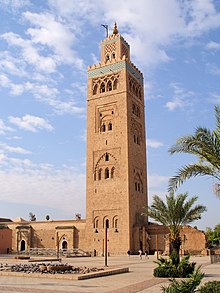
Back جامع الكتبية Arabic لكتبية ARY جامع الكتبيه ARZ Әл-Көтөбиә Bashkir Кутубія Byelorussian Кутубия Bulgarian Mesquita Kutubia Catalan Mešita Kutubíja Czech Koutoubia-Moschee German Moskeo Kutubia Esperanto
| Kutubiyya Mosque | |
|---|---|
 | |
| Religion | |
| Affiliation | Islam |
| Branch/tradition | Sunni |
| Location | |
| Municipality | Marrakesh |
| Country | Morocco |
| Geographic coordinates | 31°37′27″N 7°59′37″W / 31.624124°N 7.993541°W |
| Architecture | |
| Type | mosque |
| Style | Moorish (Almohad) |
| Founder | Abd al-Mu'min |
| Groundbreaking | 1147 (first mosque) |
| Completed | between 1158 and 1195 (current mosque) |
| Specifications | |
| Minaret(s) | 1 |
| Minaret height | 77 m |
| Materials | brick, sandstone, wood |
The Kutubiyya Mosque or Koutoubia Mosque (Arabic: جامع الكتبية Arabic pronunciation: [jaːmiʕu‿lkutubijːa(h)])[a] is the largest mosque in Marrakesh, Morocco.[2] It is located in the southwest medina quarter of Marrakesh, near the Jemaa el-Fnaa market place, and is flanked by large gardens.
The mosque was founded in 1147 by the Almohad caliph Abd al-Mu'min right after he conquered Marrakesh from the Almoravids. A second version of the mosque was entirely rebuilt by Abd al-Mu'min around 1158, with Ya'qub al-Mansur possibly finalizing construction of the minaret around 1195.[3] This second mosque is the structure that stands today. It is an important example of Almohad architecture and of Moroccan mosque architecture generally.[3] The minaret tower, 77 metres (253 ft) in height, is decorated with varying geometric arch motifs and topped by a spire and metal orbs. It likely inspired other buildings such as the Giralda of Seville and the Hassan Tower of Rabat, which were built shortly after in the same era.[4][5][6][7] The minaret is also considered an important landmark and symbol of Marrakesh.[8][9]
- ^ Cite error: The named reference
Archwas invoked but never defined (see the help page). - ^ Wilbaux, Quentin (2001). La médina de Marrakech: Formation des espaces urbains d'une ancienne capitale du Maroc (in French). Paris: L'Harmattan. p. 101. ISBN 2747523888.
- ^ a b Deverdun, Gaston (1959). Marrakech: Des origines à 1912 (in French). Rabat: Éditions Techniques Nord-Africaines. pp. 172–194.
- ^ Cite error: The named reference
:14was invoked but never defined (see the help page). - ^ Ewert, Christian (1992). "The Architectural Heritage of Islamic Spain in North Africa". In Dodds, Jerrilynn D. (ed.). Al-Andalus: The Art of Islamic Spain. New York: The Metropolitan Museum of Art. pp. 85–95. ISBN 0870996371.
- ^ Bennison, Amira K. (2016). The Almoravid and Almohad Empires. Edinburgh University Press. pp. 306–314. ISBN 9780748646821.
- ^ Hattstein, Markus and Delius, Peter (eds.) Islam: Art and Architecture. h.f.ullmann.
- ^ Gregg, Gary S. (15 February 2007). Culture and Identity in a Muslim Society. Oxford University Press. p. 62. ISBN 978-0-19-531003-0. Retrieved 7 October 2012.
- ^ Wilbaux, Quentin (2001). La médina de Marrakech: Formation des espaces urbains d'une ancienne capitale du Maroc (in French). Paris: L'Harmattan. pp. 101–102, 238–243. ISBN 2747523888.
Cite error: There are <ref group=lower-alpha> tags or {{efn}} templates on this page, but the references will not show without a {{reflist|group=lower-alpha}} template or {{notelist}} template (see the help page).
© MMXXIII Rich X Search. We shall prevail. All rights reserved. Rich X Search
